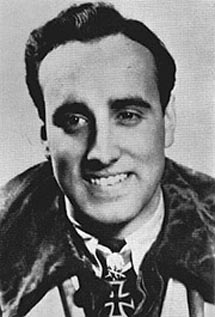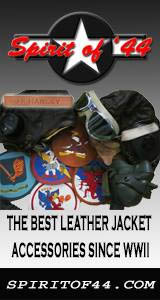Heinz-Wolfgang Schnaufer

Last Wartime Rank: Major
Unit(s): NJG 1, NJG 4
Combat Debut: Spring 1942
Theatre(s): Western Front
Victories: 121
Sorties: 164
Radio/Radar Operator:Fritz Rumpelhardt
Notes:
Know as the "Spook of St. Trond" by the British.
Germany's top night fighter ace.
Unit(s): NJG 1, NJG 4
Combat Debut: Spring 1942
Theatre(s): Western Front
Victories: 121
Sorties: 164
Radio/Radar Operator:Fritz Rumpelhardt
Notes:
Know as the "Spook of St. Trond" by the British.
Germany's top night fighter ace.
Schnaufer was born in a Stuttgart maternity home on the 16th February
1922. His home was in the Black Forest township of Calw, and he was to
be the eldest of four children, three boys and a girl. Although
christened 'Heinz Wolfgang" ("Wolfgang" after his godfather) he was
universally known simply as "Heinz". He grew up in prosperous
circumstances, his father being a wine-merchant of some substance. He
was gifted both academically and athletically, and in 1938, at the age of
16, entered the NPEA (National Political Educational Establishment) at
Backnang, moving the following year to the NPEA at Potsdam. An NPEA was
a training school for young men specially selected for advancement in the
service of the National Socialist Party, and Potsdam was the NPEA at
which those opting for a flying career in the Luftwaffe were introduced
to flying training.
Heinz Schnaufer entered the Luftwaffe as a trainee officer-pilot in
November 1939, and completed his flying training in 1941. At the Heavy
Fighter School (Zerstorerschule) at Wunstorf he met Fritz Rumpelhardt,
who became his Funker (radio/radar operator) and flew with him, with a
break in 1943, until the end of the war. At this time Schnaufer and
Rumpelhardt agreed to volunteer to fly with the newly-formed Nachtjagd,
the night-fighter arm of the Luftwaffe. In November 1941, on completion
of their flying training, they were posted to II./NJG 1 at Stade, near
Hamburg, later transferring with the same unit to Saint-Trond, Belgium.
Throughout his career Schnaufer only flew the Bf 110 operationally,
despite subsequently commanding a Geschwader equipped with the Ju 88.
Schnaufer's first operational experience came in February 1942, when
II./NJG 1 were detached to fly escort for the capital ships Scharnhorst,
Gneisenau and Prinz Eugen when they broke out from Brest en route for
Norway. His first 'kill', however, did not come until the night of
1st/2nd June 1942, when he shot down a Handley-Page Halifax near
Louvain, Belgium. By the end of the year his score stood at only 7,
including three in a night on 1 August. It has often been said that
Schnaufer was a "slow starter", but at that time Bomber Command activity
in his area was only moderate.
Schnaufer was promoted Oberleutnant in July 1943, when his score stood at
17. In August he transferred to IV./NJG 1 at Leeuwarden, Holland, where
he became Staffelkapitän 12./NJG 1 (IV./NJG 1). He remained there, with
a detachment to Quakenbruck in September/December 43, until March 1944,
when he was appointed Kommandeur IV./NJG 1 and moved with the unit back
to Saint-Trond. By this time he had shot down 47 RAF bombers. There was
also, by this time, a third man in Schnaufer's crew, Wilhelm Gansler,
employed mainly as a look-out, an "extra pair of eyes". In December 1943
Schnaufer had been awarded the Ritterkreuz, with his score standing at
42.
Schnaufer remained as Kommandeur IV./NJG 1 until November 1944, being
promoted Hauptmann in May 1944 and receiving the Eichenlaub in June
after 84 victories. He was awarded the Schwerter in July, with his score
at 89. In July, too, his two crewmen, Rumpelhardt and Gansler, were
awarded the Ritterkreuz. In September 1944 IV./NJG 1 retreated back into
Germany, being stationed temporarily at Dusseldorf and Dortmund.
Schnaufer achieved his 100th night-time victory on 9 October 1944, for
which achievement he was awarded the Brillanten by Adolf Hitler.
The following month Heinz Schnaufer, still only 22 years old, was made
Kommodore NJG 4, based at Gutersloh. At the end of the year his score
was 106. In December he was promoted Major.
Schnaufer's greatest one-off success came on 21 February 1945, when he
destroyed 9 RAF heavy bombers in the course of one day, two in the early
hours of the morning and a further seven in the evening. Post-war
research suggests that in fact his total that day was 10, one claim not
having been acknowledged.
At the end of the war Schnaufer's official tally stood at 121. He was
taken prisoner by the British in May 1945 at Eggebek in
Schleswig-Holstein, but was released later that year and returned to
Calw, where he took over the reins of the family wine business, his
father having died during the war. By the time of his death in 1950 he
had built up the business to a very prosperous concern. His end came
when, during a wine-purchasing visit to France, his open sports car was
in collision with a lorry on the main road south from Bordeaux. The
lorry had failed to observe right of way and entered the main road
illegally. Heavy gas cylinders from the lorry fell on to Schnaufer's
car, at least one of them hitting Schnaufer on the head. He died in
hospital two days later, on 15 July 1950.
This summary by Peter Hinchliffe, OBE, author of "The Other Battle",
currently writing the biography of Heinz Schnaufer for Crecy Books Ltd.






